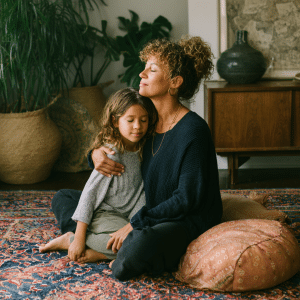Children absorb their parents’ emotions like sponges absorb water. A parent’s untreated anxiety often creates similar patterns of worry and fear in their child. This transfer occurs through daily interactions, body language, and the emotional climate that parents make at home.
The parental and child anxiety Connection
Parents with unaddressed anxiety display physical signs their children notice immediately. Tense shoulders, rapid speech, and frequent checking behaviors send clear signals that something is wrong. Children interpret these cues as evidence that the world is a dangerous place.
A parent who worries excessively about their child’s safety might hover during playground visits. They repeatedly warn about potential dangers. They ask multiple questions about simple activities. The child learns that normal childhood experiences are threats to be avoided.
Anxious parents model catastrophic thinking. They verbalize worst-case scenarios. They express worry about minor issues. Children adopt this mental framework. A delayed school bus becomes a sign of disaster. A scraped knee becomes a medical emergency.
The Language of Worry
The words parents use shape how children understand their world. Anxious parents use language that amplifies danger and minimizes their child’s ability to cope.
“Be careful” becomes a constant refrain. “What if something happens?” replaces “Have fun.” These phrases teach children that they are fragile and that their environment is full of hidden dangers.
Parents might ask leading questions that plant seeds of worry. “Are you sure you’re feeling okay?” when a child seems fine. “Did anyone say anything mean to you?” when no problems exist. These questions teach children to scan for problems that might not be there.
Breaking the Cycle of Anxiety
Parents can interrupt this pattern by addressing their own anxiety first. Personal therapy, meditation, or anxiety management techniques help parents regulate their emotions before they affect their children.
Self-awareness is the first step. Parents need to notice their physical responses to stress and their verbal reactions to uncertainty. They feel their shoulders tense or catch themselves asking worried questions. They can pause and choose a different reaction.
Modeling calm behavior teaches children that challenges are manageable and can be overcome. Parents demonstrate deep breathing during stressful moments. They verbalize positive self-talk. Children learn these same coping strategies.
Practical Changes Parents Can Make
Replace worry-based language with confidence-building words. Instead of “Be careful,” try “Have fun and trust your judgment.” Instead of “What if something goes wrong?” ask, “What are you looking forward to?”
Give children age-appropriate independence. Allow them to solve small problems independently. They succeed and build confidence in their abilities.
Validate emotions without amplifying them. A child expresses worry. Acknowledge their feelings without adding your own anxious thoughts. “You’re nervous about the test” works better than “Tests are really hard and you should be worried.”
Establish predictable routines that offer security without being rigid. Children thrive when they know what to expect. They need flexibility to handle unexpected changes.
Teaching Resilience
Anxious parents often shield their children from all discomfort. This prevents children from developing coping skills. Allow children to experience manageable challenges and support them through the process.
Children face setbacks. Help them focus on what they learned rather than what went wrong. This builds resilience and teaches them that difficulties are temporary and can be overcome.
Encourage problem-solving rather than providing immediate solutions. Children bring problems to their parents. Ask, “What do you think would help?” before offering advice.
The Long-Term Impact
Children who grow up with anxious parents often struggle with self-doubt and excessive worry throughout their lives. They may avoid new experiences, struggle with decision-making, or develop anxiety disorders themselves.
Parents who address their anxiety and change their parenting approach can raise confident, resilient children. These children learn that they can handle challenges. They know that their parents trust their abilities.
The goal is not to eliminate all anxiety from family life. Some worry is normal and protective. The goal is to prevent anxiety from becoming the dominant force that shapes how children see themselves and their world.
Parents who take steps to manage their anxiety give their children a powerful gift: the belief that they are capable and that the world, while sometimes challenging, is fundamentally safe.
If you live in or near Delaware and are looking for a therapist who specializes in anxiety, give us a call. We have therapists who work with children, teens, and adults. www.ccddelaware.com


